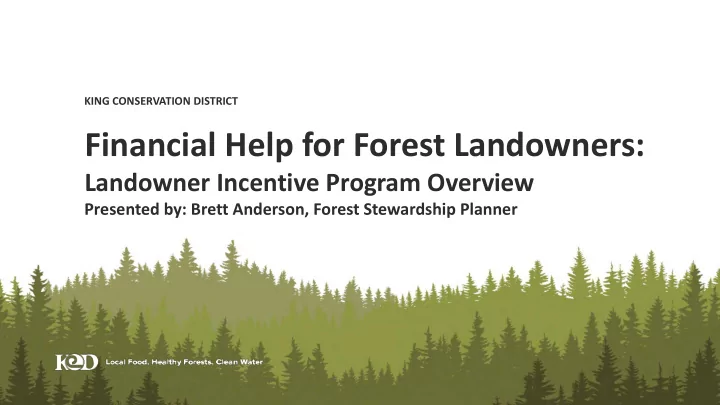

KING CONSERVATION DISTRICT Financial Help for Forest Landowners: Landowner Incentive Program Overview Presented by: Brett Anderson, Forest Stewardship Planner
Today’s webinar outline: KCD as an organization • The who KCD Forest Management staff • The why Historical context • The how LIP overview/requirements • LIP project overview The what and when • Summary and Q&A The “Huh?” • Additional resources •
KCD Forest Management Staff Mike Brett Lasecki, Anderson, Forestry Forest Program Stewardship Manager Planner
LIP – Landowner Incentive Program What is it? • Who is eligible? • What are the requirements? • Break for questions
LIP – What is it? Financial assistance piece of the KCD puzzle • 75% reimbursement program, up to allocated budget • Lower barriers to active forest management • Help landowners be effective land managers • Program goal – enhance forest natural resources • Contractual agreement between KCD and landowners •
LIP – Who is eligible? King County landowners • Have a current (<5 years old) Forest Stewardship Plan approved by King • County Allows for slight regulatory flexibility • Help landowners implement their stewardship plans • “I want to do A/B/C to manage my forest, but can’t because of X/Y/Z” •
LIP – What are the requirements? 15-year practice lifetime • Ongoing maintenance • Continued control of invasive weeds • Replanting if mortality occurs • 25% cost-share • Follow-up site visits from KCD throughout practice lifetime • Annual photo submission •
Any questions before we continue?
Forest Health Management Projects What do they look like? • How long do they take? • What do landowners need to do before/during/after? • What does project success look like? •
Forest Health Management Projects What do they look like? Site preparation – e.g. brush control, mowing, thinning, invasive • species treatment Replanting – only native species • Maintenance •
Forest Health Management Projects How long do they take? Installation – Initial site preparation and planting • Maintenance – Two phases • “Ours” – approximately 3 years • “Yours” – approximately 12 years • Forests are living systems, no clear ‘end’ • Year 1 through ~4: Year ~4 through 15: Project implementation, Maintenance is landowner’s responsibility contractor maintenance Year 0-1: Year ~4: Year 15: Project design, Final inspection End of installation and reimbursement contractual obligation
Forest Health Management Projects What do landowners need to do… Before? • Clearly defined goals • Get involved with your woods! • During? • Clear and responsive communication • After? • Continued maintenance of practice • Annual submission of project photos •
Forest Health Management Projects What does project success look like? Good control of invasive species • Successful establishment of plantings • Good survivorship – 80% • “Free to grow” • Landowners as active and engaged stewards •
LIP Project Partnership – KCD and Landowner Roles Landowner Solicit bids from Signs contract, Confirm Final review contractors using receives approval Clear goals for project design of LIP project documents, letter, begins work! your forest meets goals application selects bid “End” Start Project Completes LIP Provide Submits Inspects work as it occurs, design application documents for application processes reimbursement bid solicitation for approval paperwork, ongoing KCD support with maintaining the practice Continued maintenance!
LIP Project Partnership – KCD and Landowner Roles Landowner Solicit bids from Signs contract, Confirm Final review contractors using receives approval Clear goals for project design of LIP project documents, letter, begins work! your forest meets goals application selects bid “End” Start Project Completes LIP Provide Submits Inspects work as it occurs, design application documents for application processes reimbursement bid solicitation for approval paperwork, ongoing KCD support with maintaining the practice Project Phase: Continued maintenance! Scoping Bidding Application Implementation
Today’s webinar outline: KCD as an organization • The who KCD Forest Management Staff • The why Historical context • The how LIP overview/requirements • LIP project overview The what and when • Summary and Q&A The “Huh?” • Additional resources •
Resources and contacts Natural Resources Conservation Service – EQIP cost-share Contact: Josh Himsl – Joshua.Himsl@wa.usda.gov (253) 256-6744 / (253) 245-0567 King County Forestry Program – Planning assistance, property tax savings Contact: Wendy Sammarco – WSammarco@kingcounty.gov (206) 263-6916 / (206) 477-4800 Washington Department of Natural Resources – Planning assistance Contact: Matt Provencher – Matthew.Provencher@DNR.WA.gov (360) 902-1494 / (360) 819-7143 WSU Extension Forestry – Planning assistance, educational classes/webinars Contact: http://forestry.wsu.edu/nps/ And of course…KCD! – Planning assistance, LIP cost-share, Technical assistance Contact: Brett Anderson – Brett.Anderson@KingCD.org (425) 282-1953 / (425) 773-8037
Thank you!
Recommend
More recommend